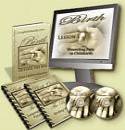Routine Newborn Baby Care Procedures
Choices for newborn baby care procedures begin immediately at birth. The best preparation is to have considered them and decided beforehand what procedures you want or would rather decline for your newborn. For a hospital birth, there are numerous routine procedures which can be administered, delayed or even refused. Unfortunately, first time parents are often unaware that many of these routine procedures are not grounded in evidence-based practice, but are rather the product of ease and access for staff.
Many parents don't realize the impact that these procedures can have on their newborn child. Once you have decided what procedures you prefer and whether you want them performed immediately or on a delayed schedule, the best way to communicate them to staff/caregivers is to include a Newborn Baby Care section in your birth plan. This will ensure that your preferences are on paper before the birth and remove any doubt as to your wishes for your new child after birth.
Another critical point to remember is that you can and absolutely have the right to receive information about each and every procedure that will be performed, as well as the right to either request the procedure be performed in your room or that a parent/guardian accompany the newborn for each one. This includes weighing, measuring and the pediatrician's evaluation of the baby - in most instances all can be performed right there in the mother's room. Remember, your first responsibility is to the welfare of your child, not to the comfort of the hospital staff nor arbitrary hospital policies.
The most commonly performed routine newborn baby care procedures to consider are:
- Suctioning
- Delayed Cord Clamping Vs. Immediate Cord Clamping
- Newborn Vitamin K Injection
- PKU Test
- Silver Nitrate or Antibiotic Eye Ointment
- Hep B Vaccine
- To Bathe or Not to Bathe
- Circumcision
Suctioning
For most hospital births, it is routine procedure to suction the baby's mouth and nose as soon as the head emerges on the perineum, in advance of its full birth. Either a deep suction hose or a bulb syringe will be used to extract any mucus or meconium that may be present.
According to the International Guidelines for Neonatal Resuscitation (2000), only approximately 5-10% of newborns will require some degree of active resuscitation (stimulation to breathe) at birth, which can vary from simple skin rubbing to suctioning or full resuscitation. This in turn means that 90-95% of all newborns need no assistance breathing at birth.
While it may seem wise to suction as soon as possible, the reality is that the baby is not at great risk of breathing difficulties at this point since it will typically not take its first breath until it has been fully birthed. As long as the cord is pulsating and is not clamped, cut, nor compressed, the baby will continue to receive oxygen via the placenta until after it has been fully birthed. There is rarely a clear need to hurry the neonatal transition to breathing room air at this early stage when only the baby's head has emerged.
Suctioning can be delayed until after the baby has been born. Alternately, suctioning can only be performed when indicated rather than a routine procedure for those infants who do not need it, as most infants will be able to clear their own airways with no outside assistance. Two excellent articles that address the importance of being "hands off" at birth are: http://www.midwiferytoday.com/articles/phaseii_79.asp and http://www.nurturingheartsbirthservices.com/blog/?p=447.
Cord Clamping
The next and perhaps most critical newborn baby care decision to be made for your baby's welfare is cord clamping - immediate or delayed. The benefits of delayed cord clamping, which is defined as waiting until the cord has stopped pulsating until clamping or cutting it, are well-documented. Once the baby is born, its entire circulatory system undergoes an amazing transformation to allow the baby to receive oxygen via its lungs rather than through the umbilical cord - a valve in the heart closes, the lungs perfuse with blood and eventually a first breath is taken. When this delicate balance is interrupted by prematurely severing the child's lifeline, its umbilical cord, numerous undesirable side effects can occur.
Newborn Vitamin K Injection
All newborns are born with a low level of Vitamin K which is responsible for preventing hemorrhage by enhancing the blood's clotting ability. In a small percentage of newborns, cerebral hemorrhage can occur which spurred the universal practice of newborn vitamin K injections in the United States. There are, however, some points to ponder when considering this intervention, especially the alternative of an oral dose.
PKU Screening
Certain metabolic disorders, including a PKU test, are routinely screened for at birth through a heel stick blood sample. These disorders have devastating effects that are best handled with early detection and treatment to ensure the best possible outcomes. This is the least controversial newborn baby care procedure since the benefits clearly outweigh the risks.
Hep B Vaccine
The Hep B Vaccine, a disease that is transmitted via infected blood and sexual intercourse, is given at birth in the hope of catching as many people as possible. It is not required for administration at birth and may be given at any time in childhood or adulthood. In low-risk families, it may be advisable to delay the administration to the weeks after birth, rather than injecting a minutes-old baby, causing pain as one of its first experiences outside the womb.
Silver Nitrate or Antibiotic Eye Ointment
To prevent the chance of blindness due to gonorrhea from an infected mother, hospital-born babies are given silver nitrate or other antibiotic drops in their eyes, even if the mother previously screened negative for this or other STDs in her pregnancy. Silver nitrate causes pain, burning, swelling and blurred vision for the first days of life and in the vast majority of cases, is not needed when the mother is known to be free from infection.
To Bathe or Not to Bathe
If there is one newborn baby care procedure that many families never consider, it's bathing a newborn. However, this may indeed be something a new family decides to decline. The vernix which coats the baby's extremely sensitive skin is the best natural moisturizer available and will protect it from infection when massaged into the skin. Additionally, a bath can cause a baby's body temperature to drop, thus necessitating further interventions to regulate it.
Circumcision
Male circumcision, and female circumcision, for that matter, are very controversial subjects. Some religions require circumcision. However, there are no proven medical benefits to the procedure and significant drawbacks. It is now considered a cosmetic procedure and its routine performance is being phased out in many areas. The American Academy of Pediatrics no longer supports it. In Australia, public hospitals are no longer performing routine circumsions.
Please give due diligence to your decision in this matter. There is little research supporting it as a routine procedure. If you are uncertain whether or not to circumcise your son, consider viewing a circumcison video to understand what the newborn will experience. The majority of circumcisions are done with no anesthesia as it can cause swelling which makes the surgery more difficult and can lead to further complications. Some will use topical anesthetic creams; however, these take 45 minutes to numb the area so most are not yet active when the surgery is performed, and their use has not been approved or studied in newborns.
Carefully consider your newborn baby care options, especially if birthing in a hospital. Over 1 million healthy infants each year spent up to 3 days in the NICU for "observation" in the United States, with many unneeded interventions simply because the technology exists. If at any time you have questions about a procedure for your newborn, don't hesitate to ask. You are your child's first and foremost advocate - be the voice they lack.
Return from Newborn Baby Care to Giving Birth Naturally Home
Page Last Modified by Catherine Beier, MS, CBE
Most Popular
How to Use Acupressure to Induce Labor
Childbirth Relaxation Script MP3s
Nutrition During Pregnancy - Nix the Notion of Eating for Two
Looking for a Birth Professional? Search our Provider Directory
Online Childbirth Classes
Choose 7 week, 12 week, or Self- Paced online childbirth classes available wherever and whenever you need them.
Featured Birth Story
Vanessa's natural birth story shows that when birth is left alone to proceed as it should, it waits for no one - not even doctors or midwives.
Free Pregnancy Tickers
Create a free pregnancy ticker to post on your blog, website, Facebook profile or favorite social media...




